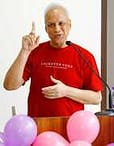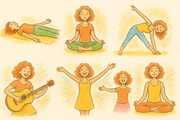Shri Jagat Singh Bisht
(Master Teacher: Happiness & Well-Being, Laughter Yoga Master Trainer, Author, Blogger, Educator, and Speaker.)
Authored six books on happiness: Cultivating Happiness, Nirvana – The Highest Happiness, Meditate Like the Buddha, Mission Happiness, A Flourishing Life, and The Little Book of Happiness. He served in a bank for thirty-five years and has been propagating happiness and well-being among people for the past twenty years. He is on a mission – Mission Happiness!
☆ # 04: Effortless practices for Happiness and Stress Management ☆
KEEP EVOLVING, KEEP LEARNING
A musician must make music, an artist must paint, a poet must write, if he is to be ultimately happy. What a man can be, he must be. This need we may call self-actualization.
-Abraham Maslow
The happiest persons on this planet are engaged deeply in creative pursuits. They are constantly in a state of flow. They keep on creating, exploring, and evolving.
Happiness lies in activity. It is like a flowing river, not a stagnant pool. Keep moving. Keep exploring. Learning is fun. Be a lifelong learner. Grow. Evolve. One who learns continuously, one who evolves continuously, one who is never stagnant, always remains cheerful, happy, and forward looking. There is no anxiety, depression, or stress.
Action may not always bring happiness but there is no happiness without action. Happiness is not something ready-made. It comes from your own actions. You must do the work to achieve it.
The happiest persons on this planet are engaged deeply in creative pursuits. They are constantly in a state of flow. Time stands still for them. They never face boredom. One level of creativity leads to the next level. They keep on creating, exploring, and evolving. They exist at a different plane altogether.
Flow is total absorption in an activity – you lose sense of time and self. When you are in flow – deep into music, play, work, reading, or smiling with your child – oblivious of time and self, you are in heaven.
CREATE YOUR OWN HAPPINESS
What are you good at? What do you love doing? What is it that gives you contentment? Keep a palm on your heart and choose that activity honestly. Do not choose what others are doing or what you think will make you famous. Choose the activity that you are good at and find genuinely absorbing.
Try to find ways and means to do the activity as often as possible. Go deep into it and learn all the finer points. Develop your skills in the field, be a learner of the deepest level, and master all the skills needed to be the best in the field. Do not compare or compete with anyone else, compete with yourself, and be your best self.
Challenges will come. Overcome those challenges by hard work and matching your skills to meet the challenge. Stretching yourself more and more will take you to newer heights. You will be fully immersed in what you do. You will learn new skills every day. You will grow every day. You will evolve on an ongoing basis. There is no happiness like this.
Keep evolving, keep learning something new all the time. Think differently and be connected to creativity. Read a book, listen to music, paint, watch a movie, write poetry, pen a short story, record a video with a good message – anything meaningful and beautiful enough to engage you with intensity.
Create or immerse yourself in the creation of another mind. You may start with immersing yourself in the creativity of others and gradually learn to be creative in your own way. Do not be in a hurry. People often make the mistake of taking a jump before they are fully ready. Learning an art or a science takes a long time and requires patience and hard work.
You can create your own happiness by voluntarily engaging in activities like helping someone, being kind, expressing gratitude, nurturing social relationships, increasing flow experiences, practicing yoga and meditation, exercising regularly, and savouring life’s little pleasures. Choose the activities that you like and practice them regularly.
OPTIMAL EXPERIENCE
One must carefully understand each word of what Mihaly Csikszentmihalyi says about engagement and happiness, “Happiness is not something that happens. It is not the result of good fortune or random chance. It is not something that money can buy or power command. It does not depend on outside events, but rather on how we interpret them.
“Happiness, in fact, is a condition that must be prepared for, cultivated, and defended privately by each person. People who learn to control inner experience will be able to determine the quality of their lives, which is as close as any one of us can come to being happy.
“The best moments in our lives are not passive, receptive, relaxing times. The best moments usually occur when a person’s body or mind is stretched to its limits in a voluntary effort to accomplish something difficult and worthwhile. Optimal experience is thus something that we make happen.”
Flow is the psychology of optimal experience. The optimal state of inner experience is one in which there is order in consciousness. During flow, people experience deep enjoyment, creativity, and a total involvement with life.
Mihaly Csikszentmihalyi says, “By stretching skills, by reaching toward higher challenges, a person, who has achieved control over psychic energy and has invested it in carefully chosen goals, becomes an increasingly extraordinary individual.”
PLATEAU EXPERIENCE
Abraham Maslow coined and defined the term “plateau experience” as a sort of continuing peak experience that is more voluntary and one that requires a lifetime of long and arduous effort.
Maslow describes the experience, “Such people who appear to be in harmony with their lives often have moments of an extraordinary occurrence called ‘peak experiences’. These are profound moments of intense rapture and well-being, along with possibly the awareness of ultimate truth and the unity of all things. Accompanying them is a heightened sense of control over the body and emotions and a wider sense of awareness.”
According to Ed Diener, “Psychological wealth includes life satisfaction, the feeling that life is full of meaning, a sense of engagement in interesting activities, the pursuit of important goals, the experience of positive emotional feelings, and a sense of spirituality that connects people to things larger than themselves.”
EXERCISE
Making the right decisions.
Imagine you have a collection of six hats of different colours – white, red, black, yellow, green, and blue. These are your tools for arriving at the right decisions in complex life situations.
Think of a problem that you have been facing. The problem is confusing and perplexing. You are finding it difficult to arrive at a solution.
Let us begin solving it in a creative and systematic way.
Begin with wearing the white hat.
The white hat denotes purity. You look only at the pure data. Just information and facts of the case. No opinion, views, or prejudices.
You may write down the problem and all related data on a sheet of paper, or prepare a document on your computer.
Make sure it is pure data, no opinions, or pre-conceived notions.
Take off the white hat and put on the red hat.
The red hat denotes emotions. Only emotions. What you feel. No logic, pure emotions.
Express and go through all the emotions. Your fears, anxieties, and hopes about the case. Whatever you feel. Let the whole range of feelings – positive, neutral, and negative – flow. No justifications needed.
Be as irrational and emotional as you can.
Take off the red hat and put on the black hat.
The black hat is the devil’s advocate. Everything that is wrong and that may go wrong in the case. All the failures, drawbacks, and negatives about the case. The emotional as well as the logical dark side.
Imagine all that can go wrong and the havoc that may be created.
Now, take off the black hat and put the yellow hat.
Yellow is the colour of sunshine, positivity, and optimism. Look at the brighter side of the problem and list all that is good and full of hope about it.
Look at all the positives and be full of optimism and hope.
Take off the yellow hat and put on the green hat.
Green is the colour of creativity and nature. Be creative. Look at the problem from totally different perspectives. Be creative. Think laterally. Think something new, innovate, and out of the box.
Imagine what no one has ever thought about the problem. Be disruptive in your thinking, not just incremental. Find totally new solutions. Brainstorm to the fullest. Use your whole range of thinking – make use of the entire rainbow.
Now, put down the green hat and put on the blue hat.
Blue is the colour of the sky. It covers everything.
Consider whatever you have thought and felt wearing all the hats – white, red, black, yellow, and green – and summarize them. You must arrive at a balanced decision, taking everything into consideration. You must weigh all the pros and cons.
Make the ultimate decision. Let there be no doubt in mind. All apprehensions must be given consideration and cleared. Take very single factor into account and arrive at the most comprehensive decision.
Your decision should not be lopsided or taken without considering any angle. Let it be all encompassing.
You arrive at the right decision and there is no stress.
This method of arriving at a balanced decision in complex situation has been devised by Edward de Bono and is known as the Six Thinking Hats.
Not being able to reach at the right decisions causes stress and anxiety. Knowing how to make the right decisions relieves you of stress. If you have a thinking mind, if you are creative, if you are positive, if you believe in activity, and if you are not afraid to take the right decisions, you will always be happy and stress-free.
“Thinking is the ultimate human resource. Yet we can never be satisfied with our most important skill. No matter how good we become, we should always want to be better. The main difficulty in thinking is confusion. We try to do too much at once. Emotions, information, logic, hope, and creativity all crowd in on us. It is like juggling with too many balls. The six thinking hats allow us to conduct our thinking as a conductor might lead an orchestra. We can call forth what we will.”
Six Thinking Hats/ Edward de Bono
“A good life is one that is characterized by complete absorption in what one does.”
Jeanne Nakamura and Mihaly Csikszentmihalyi
♥ ♥ ♥ ♥
© Jagat Singh Bisht
Master Teacher: Happiness & Well-Being, Laughter Yoga Master Trainer, Author, Blogger, Educator, and Speaker
FounderLifeSkills
A Pathway to Authentic Happiness, Well-Being & A Fulfilling Life! We teach skills to lead a healthy, happy and meaningful life.
The Science of Happiness (Positive Psychology), Meditation, Yoga, Spirituality and Laughter Yoga. We conduct talks, seminars, workshops, retreats and training.
≈ Editor – Shri Hemant Bawankar/Editor (English) – Captain Pravin Raghuvanshi, NM








 ~
~






